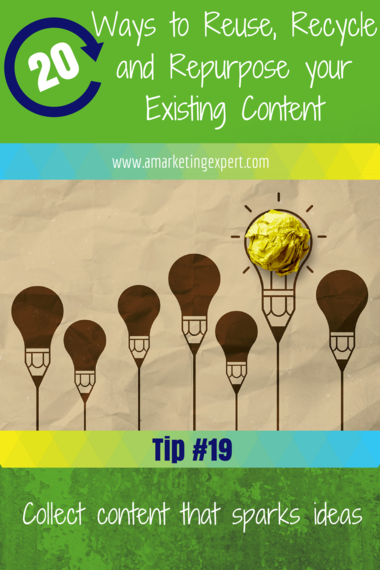Reuse, Repurpose, Recycle: How to Maximize Existing Content., Generate Quick Ideas and Cut Your Blogging Time in Half
By now we’ve all heard the endless chatter about Google’s issues with duplicate content. In the past, we could easily re-run pieces in a variety of places. Some experts I know reused articles as many as twenty times, but if you do that now you may find your site in a lot of trouble and severely penalized by the Google-Gods. So what’s a marketer to do? I was considering this the other day when I was trying to figure out what to blog about because the other issue is that Google does not want “thin” content, which is content that isn’t compelling, thin in data or light in information. Basically they don’t want people just throwing stuff on their blog to get traffic.
We’re all in a creative industry but that does not necessarily mean that we are an endless font of creative ideas. Then I thought: instead of coming up with new ideas, I wonder how many times I can reuse old ones in a way that won’t get us into trouble. So here are twenty of them, a variety of different things you can do with the same piece of content.
Now I’m not suggesting that you do this with each and every blog post, but if you have ideas or posts that seem to have legs (and we all know that not all of them will) then maybe it’s time to see how far you can stretch them.
-
- Identify and Re-run Evergreen Content – Review your posts from the past and identify those that are evergreen (i.e. content that’s always relevant and not time-sensitive) and consider republishing them with a timely revision that acknowledges new statistics and trends.
- Update Past Posts with Industry Updates – At some point, even the best and most creative posts need to be updated. Now’s the time to go through your old posts and see what can be updated and reused. Pull in new content and add a fresh take, your readers will love it.
- Pull Blog Content into an Infographic – Combine several of your text-based posts into more visual content – such as an aggregated infographic or chart.
- Tips: Create a tips list from a blog post you did and then create images from it to use on Pinterest, in Twitter, on Instagram, etc. We did this for our 52 Ways to Sell More Books.
- Quizzes: People love quizzes, when we did ours on “Which Social Media Site is Right for You” people just ate it up. Most of the time it’s just grabbing existing content you’ve done, but it’s a fantastic way to repurpose your stuff. You can see it here.
- Checklists: People love checklists, too and in most cases content can be easily turned into a checklist. It doesn’t have to be complicated or long. We did a checklist about all of our Amazon content (How to Sell Books by the Truckload).
- Forms: Can any of your content be turned into forms or one-page worksheets?
- Top Ten Lists: Another great use for articles is top ten lists. And like anything related to checklists, top tens, etc. sometimes you’ll have to play with the information to get it to fit this format. But most content only needs a slight tweak to morph into something like this.
-
- Did You Know Posts: So let’s say you’ve written a few articles on Twitter. Why not pull them together into a “did you know” and then refer back to the posts themselves? Not only is this great, short content (and also super for graphics) but you can highlight other blog posts, too.
-
- Compile a “Best Of” Post – Once a month, create a best-of post of all your content (or other content) that you really love and want to share. This does not have to be everything you’ve written so, technically, it may not be entirely recycled content but it’s still a great way to share content and become a trusted content aggregator.
-
- Round Up Your Posts -Use or Reuse Content for your Newsletter
-
- Create a FAQ Post – Identify common questions from your audience, type up quick answers to each, then turn that into a blog post that refers back to your evergreen posts
-
- Expand On a Recent Blog Comment – If you’re commenting on blogs (and you should be) why not create a post about a particular comment or viewpoint?
-
- Create Bite-Sized Blog Posts or Mini Versions of Some of Your Most Popular Posts: Many of my posts are long, and by long I mean longer than 500 words, so I’ll take bites of that and create images with quotes, or excerpt pieces for social media updates, etc.
-
- Evolve Your Webinar into Blog Content or an eBook: I do a ton of webinars and I love doing this. You’ll want to get permission first if someone else is hosting your webinar but it’s fantastic for building content that can be used for blog posts and eBooks. When I did my first How to Sell Books by the Truckload on Amazon session with Joan Stewart, I got her ok to transcribe it. Now it’s a book series on Amazon.
-
- Leverage Video Content – Transcribe an existing video, such as an interview or class, and use it as a blog post.
-
- Add Your Presentation to SlideShare: Or create a presentation from your blog content for SlideShare.
-
- Create Event Content – I do this a lot, I’ll go to an event, take notes and turn them into blog posts; sometimes I’ll supplement them with videos taken at the event.
-
- Content that Sparks Ideas: When I travel I take my magazines with me and often plow through them on the road. I tear out pages that have interesting stuff on them and then recycle the rest. I will highlight things that spark ideas or bits I want to share. Then I’ll use this for an article, or a graphic with a tip (citing the publication). Here’s another tip: I use Evernote to save all my ideas and bought the scanner they recommended, but I didn’t buy it on Evernote, I found the same one on Amazon for much less. It will scan your stuff into Evernote (or Dropbox) which is great because you won’t have a ton of paper notes all over the place.
- Turn content into trading cards or other swag: I had trading cards made for my book, How to Sell Your Books By The Truckload on Amazon. I pulled different tips I had already written, and put one tip per card. I took these around to speaking events and people loved them. You could do this with content from past popular blog posts or other articles you’ve written. While it’s not online content per se, people love these cards, and I mail them with everything. I also give them out at speaking events, too. Keep in mind that everyone loves swag.
It’s important that we get as much mileage out of what we write as we possibly can, and with all of the new places to post (Pinterest, Instagram, Vine, etc.) it’s become easier than ever to create virtual “breadcrumbs” that lead readers back to our website which, in the end, is the ultimate goal.



